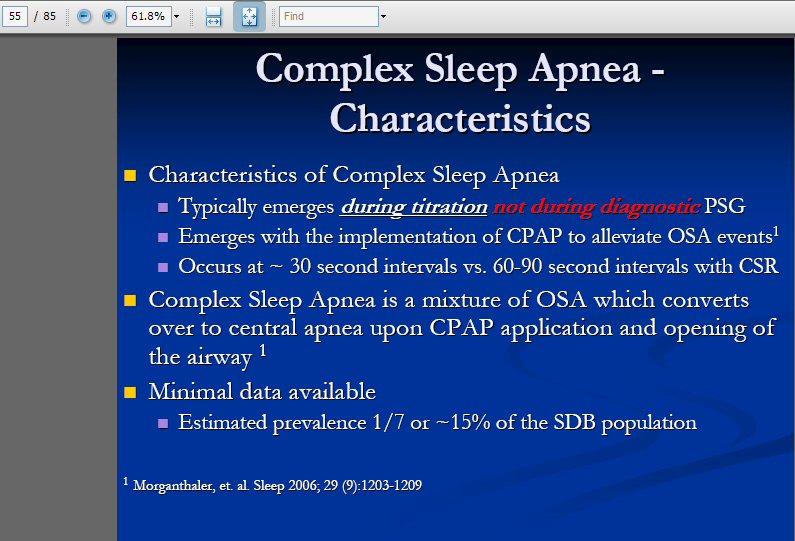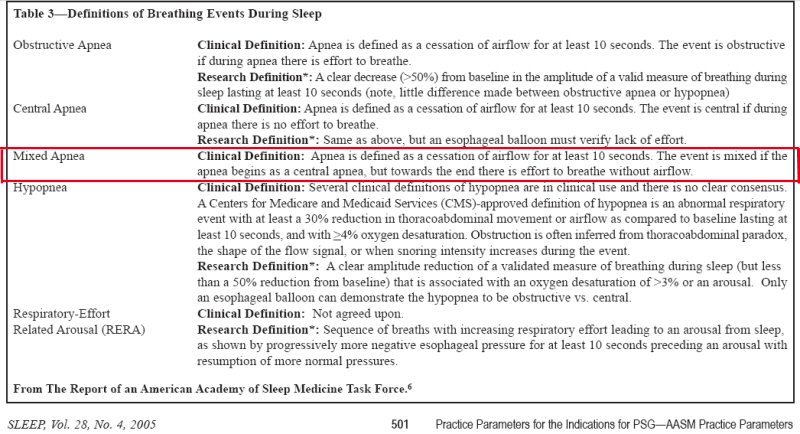Mixed Apnea
===========
I agree that it doesn't seem to make sense that an obstruction can become a central
& Ozij in a post above has framed questions about how this can occur. RestedGal
has posted a reference to a 2005 Update document that only describes centrals
becoming obstructions. But, there
are later publications that explain how
obstructions can become centrals. 2005 is a long time ago in SDB history
Below is the info I have that explains how Mixed Apneas can consist of two variants
Type 1 is the normal & better understood mixed apnea being central=>obstruction, and
type 2 is the less well understood mixed apnea which is when obstruction=>central.
The way I understand an obstruction can become a central is when hypoxia
and hypocapnia triggered by the obstructive phase induce signs & symptoms of a
central apnea as the 2nd phase.
Hypoxia is the lowering of oxygen level. The hypocapnia results from a paCO2 imbalance
(blood CO2 becomes too low) which in turn impacts the respiratory drive. The hypocapnia
signals the sleeper to not breathe while their paCO2 level builds up. One way the
paCO2 level can drop is when the sleeper gasps & hyperventilates momentarily after
the obstructive event & the resulting hypocapnia triggers the central phase.
Below I have highlighted several papers that I understand support this.
DSM
********************************************************************************
(NOTE: This para explains the type 1 then highlights how type 2 can occur)
http://www.ncbi.nlm.nih.gov/pmc/articles/PMC2698052/
The occurrence of apnea leads to several consequences that conspire to promote
further breathing instability. The first is the inertia of the ventilatory
control system that prevents the return of rhythmic breathing until PaCO2 increases
by 4–6 mmHg above eupneic arterial PCO2 [19]. In addition, central apnea is
associated with narrowing or occlusion of the pharyngeal airway [20]. Thus,
resumption of ventilation requires opening of a narrowed or occluded airway and
overcoming tissue adhesion forces [21] and cranio-facial gravitational forces.
Termination of central apnea is associated with variable asphyxia (hypoxia and
hypercapnia) and transient arousal, resulting in ventilatory overshoot, subsequent
hypocapnia, and further apnea/hypopnea. This sequence explains the overlap between
central and obstructive apnea
(upper airway obstruction often follows central
apneas upon resumption of respiratory effort, i.e., mixed apnea).
................
http://chestjournal.chestpubs.org/content/89/6/800
... in three patients, pauses in inspiratory effort following experimental obstructive apnea were
prevented by administration of 4 percent CO2 and 40 percent O2 inspired gas. This study suggests
that: hyperventilation with hypocapnia occurs at the termination of obstructive apneas,
and
hypocapnia may be responsible for the attenuation or cessation of respiratory effort initiating
the subsequent cycle of obstruction.
................
http://medical-dictionary.thefreedictio ... leep+apnea
mixed sleep apnea,
a condition marked by signs and symptoms of both central sleep apnea and obstructive sleep apnea.
It often begins as central sleep apnea and develops into the obstructive form.
Mixed sleep apnea
may also result from obstructive sleep apnea as hypoxia and hypercapnia induce signs and symptoms
of the central form.
................













